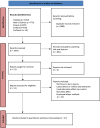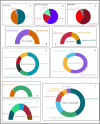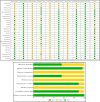Synergistic effects of mesenchymal stem cells and their secretomes with scaffolds in burn wound healing: a systematic review and meta-analysis of preclinical studies
- PMID: 40598532
- PMCID: PMC12210777
- DOI: 10.1186/s12967-025-06712-y
Synergistic effects of mesenchymal stem cells and their secretomes with scaffolds in burn wound healing: a systematic review and meta-analysis of preclinical studies
Abstract
Background: Burn injuries cause severe physical and psychological challenges. Current treatments have limitations, such as incomplete skin regeneration and prolonged healing times, necessitating innovative solutions. Tissue engineering integrates mesenchymal stem cells (MSCs) and scaffolds in preclinical studies to enhance healing, reduce scarring, and regenerate skin. This study examines their combined effects to optimize burn wound therapies.
Methods: This systematic review and meta-analysis was conducted per PRISMA guidelines, with the protocol registered in PROSPERO. Databases (PubMed, Embase, Scopus, Web of Science, ProQuest) were searched for published studies.The SYRCLE tool assessed risk of bias. Standardized mean difference (SMD) evaluated the therapeutic effect of MSC-scaffold combinations. Statistical analysis employed a random-effects model. Sensitivity analysis, publication bias assessment, and subgroup analysis addressed heterogeneity.
Results: Our meta-analysis reveals that animals treated with MSC-scaffold combinations exhibit enhanced wound closure compared to untreated controls across short-term (SMD = 3.97), mid-term (SMD = 3.47), and long-term (SMD = 3.03) timeframes. Additionally, MSC-scaffold combinations significantly improve angiogenesis (SMD = 6.24), collagen deposition (SMD = 4.97), and growth factor expression (SMD = 6.68), while effectively modulating inflammatory cytokine levels (SMD = -4.88).
Conclusion: Our research demonstrates that MSC-scaffold synergy in preclinical burn wound healing significantly improves wound closure, collagen deposition, angiogenesis, and growth factor expression, while effectively modulating inflammatory responses. Despite its potential as an adjunctive therapy, substantial study heterogeneity impedes clinical translation, necessitating standardized protocols to refine and validate this approach for efficacious clinical application.
Keywords: Burn; Cell therapy; Exosome; Hydrogel; Matrix; Mesenchymal stem cells; Scaffold.
© 2025. The Author(s).
Conflict of interest statement
Declarations. Ethics approval consent to participate: Not applicable. Consent for publication: Not applicable. Competing interests: The authors affirm that no conflicts of interest exist concerning this study.
Figures





Similar articles
-
Therapeutic potential of mesenchymal stem cell-derived extracellular vesicle in nonalcoholic fatty liver disease: a systematic review and meta-analysis of preclinical evidence.Lipids Health Dis. 2025 Jun 19;24(1):217. doi: 10.1186/s12944-025-02635-1. Lipids Health Dis. 2025. PMID: 40537764 Free PMC article. Review.
-
Mesenchymal stem cells-derived small extracellular vesicles and apoptotic extracellular vesicles for wound healing and skin regeneration: a systematic review and meta-analysis of preclinical studies.J Transl Med. 2025 Mar 24;23(1):364. doi: 10.1186/s12967-024-05744-0. J Transl Med. 2025. PMID: 40128791 Free PMC article.
-
Therapeutic potential of mesenchymal stromal cells for hypoxic ischemic encephalopathy: A systematic review and meta-analysis of preclinical studies.PLoS One. 2017 Dec 19;12(12):e0189895. doi: 10.1371/journal.pone.0189895. eCollection 2017. PLoS One. 2017. PMID: 29261798 Free PMC article.
-
Combination Therapy with Human Chorionic Villi MSCs and Secretory Factors Enhances Cutaneous Wound Healing in a Rat Model.Int J Mol Sci. 2025 Jul 17;26(14):6888. doi: 10.3390/ijms26146888. Int J Mol Sci. 2025. PMID: 40725137 Free PMC article.
-
The Hidden Power of the Secretome: Therapeutic Potential on Wound Healing and Cell-Free Regenerative Medicine-A Systematic Review.Int J Mol Sci. 2025 Feb 23;26(5):1926. doi: 10.3390/ijms26051926. Int J Mol Sci. 2025. PMID: 40076553 Free PMC article.
References
Publication types
MeSH terms
LinkOut - more resources
Full Text Sources
Medical

